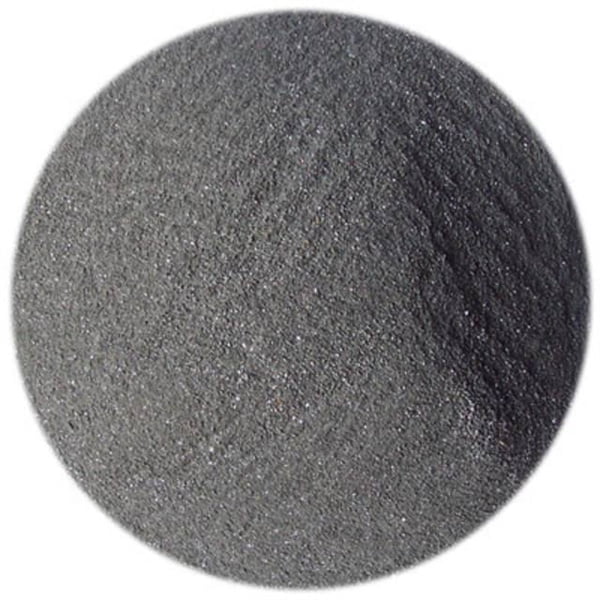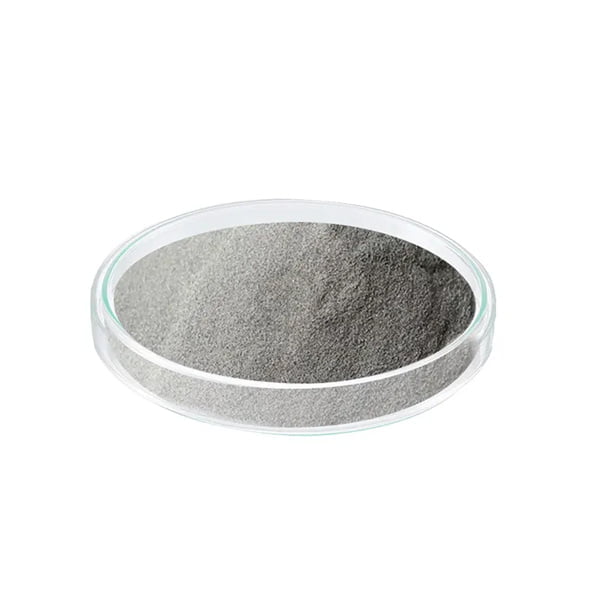耐火物粉末材料
目次
耐火物パウダー 材料は、要求の厳しい産業で使用される非常に高い耐熱性を示す無機非金属材料の特殊なクラスを表しています。この包括的なガイドは、代表的な組成、重要な特性データ、製造プロセス、アプリケーション、仕様、サプライヤーなど、耐火性粉末のすべての重要な特性を理解する技術専門家やバイヤーのお役に立ちます。
耐火物粉末材料の概要
耐火物パウダーは、1000℃を超える高温でも強度と形状を維持し、優れた熱安定性を示す細かく分割された不活性な非金属材料で構成されています。主なサブクラスとして、酸化物、炭化物、窒化物、セラミックスがあります。
重要な属性:
- 1000℃以上の耐熱性
- 熱衝撃に強い
- 耐腐食性
- 高融点
- 構造的完全性を保つ
その卓越した能力は、炉、ボイラー、キルン、反応炉など、従来の材料が急速に故障するような過酷な熱環境での性能を強化する。
典型的な構成
| 素材 | 役割 | Wt% レンジ |
|---|---|---|
| アルミナ | 熱特性 | 40-100% |
| シリカ | 行列をバインドする | 0-60% |
| マグネシア | 劣化に強い | 0-20% |
| グラファイト | 耐熱衝撃性の向上 | 0-15% |
主要成分のバランスをとることで、熱容量、断熱性、耐浸食性、融点、コストなどの特性を最適化することができる。
耐火性粉末の主な種類
| タイプ | 説明 |
|---|---|
| フューズド | 極めて高い純度、1800℃以上の耐熱性 |
| 焼結 | パウダープレス/焼成、低コスト |
| 炭化ケイ素 | 熱伝導率の高いセラミック |
| クロマイト | スラグ、金属貫通に強い |
| ジルコニア | 耐熱衝撃性 |

耐火物パウダー 材料 製造工程
| ベネフィット | 説明 | インパクト |
|---|---|---|
| 高密度、ニアネットシェイプ部品 | EBMは、使用する金属粉末の理論密度の99.5%を超える密度でパーツを作成します。これにより、他の積層造形法で一般的な気孔(小さなエアポケット)がなくなり、優れた強度、耐疲労性、寸法精度を持つ部品が得られます。 | これにより、航空宇宙産業(タービンブレード、エンジンハウジング)、医療産業(歯科インプラント、補綴物)、自動車産業(軽量、高性能部品)など、要求の厳しい用途向けの機能的金属部品の製造が可能になる。 |
| 優れた機械的特性 | EBMの高真空環境と精密な溶解プロセスにより、酸化と汚染が最小限に抑えられ、金属粉末本来の特性が維持されます。これにより、優れた引張強度、耐クリープ性(高温での応力下での変形に耐える能力)、破壊靭性を持つ部品が得られます。 | EBMで製造された部品は、大きな荷重に耐え、高温でも効果的に作動し、亀裂の進展に耐えることができるため、過酷な環境下での耐久性と構造的完全性を必要とする用途に最適です。 |
| 耐火物および反応性金属の加工 | 高融点や反応性に制限された従来の製造方法とは異なり、EBMはチタン合金、タンタル、インコネルなどの難度の高い材料の加工を得意としています。真空環境は酸化を防ぎ、溶融プロセスを正確に制御できるため、製造の成功を確実にします。 | これにより、航空宇宙やバイオメディカルなど、部品に卓越した強度対重量比、生体適合性(生体組織との適合性)、高温性能が要求される産業における設計の可能性が広がる。 |
| 複雑な形状の設計自由度 | EBMのレイヤー・バイ・レイヤー・アプローチは、従来の技術では不可能だった複雑な内部形状、チャンネル、格子構造の作成を可能にします。この設計の柔軟性により、重量配分が最適化され、熱伝達が改善され、優れた機能性を持つコンポーネントの作成が可能になります。 | この利点は、複雑な冷却チャネルを持つ軽量で高強度の部品がエンジン効率に不可欠な航空宇宙産業などの製品設計に革命をもたらす。また、患者の解剖学的構造に完全に適合する、カスタマイズされた医療用インプラントの作成も可能になる。 |
| 最小限のサポート体制 | EBMで製造された部品は、固有の強度が高いため、製造工程で必要なサポート構造は最小限です。これにより、後工程の時間と材料の無駄が削減され、最終的な部品にサポート構造が損傷するリスクも低減されます。 | これは、生産時間の短縮、全体的なコストの削減、従来の方法では困難または不可能な複雑な形状の作成につながる。 |
| 廃棄物の削減 | EBMは付加製造プロセスであり、材料を層ごとに追加して希望の形状を作り出すことを意味する。これは、最終的な形状を達成するために原材料のかなりの部分を除去する機械加工のような減法的技術と比較して、材料の無駄を最小限に抑えることができます。 | この利点は、持続可能性を促進し、材料を最大限に利用することで製造コストを削減する。さらに、ビルドチャンバーから排出される未使用のパウダーは、次のビルドに再利用できる場合が多く、廃棄物をさらに最小限に抑えることができます。 |
耐火性粉末材料の特性
| プロパティ | 代表値 |
|---|---|
| 融点 | 1600℃以上 |
| 密度 | 2 - 6 g/cm3 |
| 圧縮強度 | 20 - 100 MPa |
| 曲げ強度 | 10 - 60 MPa |
| 破壊靭性 | 2 - 10 MPa・m^1/2 |
| 熱伝導率 | 20 - 100 W/m-K |
| 電気抵抗率 | 10^8~10^13オーム・cm |
| 最高使用温度 | 1200°c - 2000°c |
融点、熱容量、耐熱衝撃性、絶縁性、化学的慣性とコストのような要件のバランスが選択を決定する。
耐火粉末材料の用途
| 産業 | 申し込み | 素材 | 利用物件 |
|---|---|---|---|
| 航空宇宙 | * タービンブレード * ロケットノズル * ヒートシールド | * タングステン * タンタル * レニウム | * 高い融点(>3000°C) * 高温での優れた機械的強度 * 優れた耐酸化性 |
| 自動車 | * スパークプラグ電極 * 排気バルブ * ターボチャージャー部品 | * タングステン * モリブデン * ニッケル合金 | * 高い導電性 * 耐摩耗性 * 耐熱衝撃性 |
| エレクトロニクス | * 高温抵抗器 * コンデンサー * 電気接点 | * タングステン * モリブデン * シルバー | * 高融点 * 低抵抗 * 耐アーク腐食性 |
| エネルギー | * 発電所の炉のライニング * 溶融塩炉 | * 炭化ケイ素 * アルミナ * ジルコニア | * 優れた熱伝導性 * 高い化学的安定性 * 溶融塩に対する耐性 |
| メディカル | * 人工股関節置換術および人工膝関節置換術 * 歯科インプラント * 放射線遮蔽 | * チタン合金 * タンタル * タングステン | * 生体適合性 * 高い強度重量比 * X線不透明度 |
| 化学処理 | * 過酷な化学環境用リアクター * 高温配管 * 熱交換器 | * タンタル * ジルコニウム * ニッケル合金 | * 耐食性 * 高温での高強度 * 優れた成形性 |
| 工具 | * 高強度材料用切削工具 * 金属成形用金型 * ガラスとセラミックスの金型 | * 炭化タングステン * 窒化ホウ素 * ダイヤモンドパウダー | * 卓越した硬度 * 高い耐摩耗性 * 低熱膨張 |
| アディティブ・マニュファクチャリング | * 複雑な金属部品の3Dプリント * 摩耗または損傷した部品の修理 | * インコネル粉末 * コバルトクロム合金 * チタンパウダー | * 正確な印刷のための高い粉末流動性 * 優れた焼結特性 * 特定の用途に合わせた微細構造 |
仕様とグレード
| プロパティ | 説明 | 選択のための主な考慮事項 |
|---|---|---|
| 化学組成 | 金属酸化物、炭化物、窒化物、セラミックスなど、粉末の主要な構成要素。 | * 支配的な酸化物: アルミナ(Al2O3)は高温強度に優れるが、耐熱衝撃性は低い。シリカ(SiO2)は耐薬品性に優れるが、耐火性は低い。マグネシア(MgO)は耐スラグ性に優れるが、水和しやすい。 * 二次添加物: カルシア(CaO)は耐スラグ性を高め、クロミア(Cr2O3)は耐摩耗性を向上させる。 * 純粋さ: 一般的に純度が高いほど性能は向上するが、コストアップにつながる可能性がある。 |
| 粒度分布 | 粉末内の個々の粒子径の範囲と広がり。 | * 平均粒径: より微細なパウダーは、充填密度と結合のための表面積に優れるが、凝集(塊状化)の影響を受けやすく、流動特性を妨げることがある。 * 粒度分布: 狭い分布は、一貫したパッキングを保証し、加工中の偏析を最小限に抑えます。より広い分布は、空隙を満たし、パッキング効率を向上させるのに有効です。 * 具体的な用途 3Dプリンティングのようなプロセスでは、最適なフローと印刷性を実現するために、より厳密なサイズ管理が必要となることが多い。 |
| 粒子の形態学 | 個々の粒子の形状と形態。 | * 形だ: 球状粒子は通常、より効率的に充填され、角状粒子は強度を向上させるために機械的インターロッキング効果を生み出すことができる。 * 表面積: 高表面積の粉末は結合性が高いが、反応性も高くなる。 * 形態制御: 用途によっては、熱伝導性を高めるためのプレートレットなど、特定の形状を優先する場合もある。 |
| 見かけ密度 | 単位体積当たりの粉末の質量。 | * 梱包効率: 見かけ密度が高いほど梱包効率が良く、材料の使用量を減らすことができる。 * 流動性: 見かけ密度が低い粉末は、一般に、取り扱いや加工が容易な優れた流動特性を示す。 * グリーン・ストレングス 見掛け密度は、成形部品のグリーン強度(焼成前)に影響を与える可能性がある。 |
| かさ密度 | 標準化されたタッピングまたは振動手順を経た後の、単位体積あたりの粉体の質量。 | * 圧縮効率: 嵩密度は、粉末の圧縮性を反映し、最終製品の密度と特性に影響を与える。 * 多孔性: 嵩比重が低いほど空隙率が高いことを示し、断熱性に影響を与えるが、機械的強度が低下する可能性がある。 * マテリアルハンドリング 嵩密度は、一定の体積にどれだけの量の粉体を効率的に貯蔵または輸送できるかに影響する。 |
| 比重 | 物質の密度と水の密度の比。 | * 耐火物の選択: 高比重材料は一般的に耐熱性に優れているが、重量が増加する可能性がある。 * 費用対効果: 比重の軽い材料は、輸送や取り扱いの費用対効果が高くなる。 |
| 屈折率 | 材料が溶けたり、構造的完全性を失ったりすることなく耐えられる最高温度。 | * 応募資格 耐火物粉末は、最終用途で予想される使用温度を上回る必要がある。 * 化学的環境: ある種の雰囲気は、耐火性に影響を与えることがある。例えば、還元性の環境は、ある種の酸化物を劣化させることがある。 |
| 熱伝導率 | 素材の熱伝導能力。 | * 熱伝達管理: 高い熱伝導率は、熱交換器など効率的な熱伝達を必要とする用途に有益である。 * 断熱: 熱伝導率が低いことは、炉の内張りのような保温が必要な用途に望ましい。 |
| 熱膨張 | 材料が加熱によって膨張する量。 | * 耐熱衝撃性: 熱膨張率の低い材料は一般に、急激な温度変化による割れや剥落に対する耐性が高い。 * 寸法安定性: 耐火物粉末の熱膨張係数を基材に合わせることで、熱サイクル中の応力発生を最小限に抑えることができます。 |
| 耐薬品性 | 腐食性化学物質や溶融金属/スラグからの攻撃に耐える材料の能力。 | * 特定の攻撃的薬剤: 耐火物が用途で遭遇する化学物質の種類を考慮して選択する必要がある。 * 酸度/アルカリ度: 酸性または塩基性の環境は、特定の耐火物を劣化させる可能性がある。 |
| その他のパフォーマンス特性 | 耐侵食性、導電性、耐摩耗性など、特定の用途に応じた追加特性。 | * ニーズに焦点を当てる: 想定されるユースケースにとって重要な性能要素を特定し、その分野に秀でたパウダーを選ぶ。 * トレードオフ: 多くの場合、様々な特性の間にはトレードオフが存在する。最適な材料を選択するには、最も関連性の高い特性に優先順位をつける必要があります。 |
耐火物パウダー 材料サプライヤー
| 会社概要 | 所在地 |
|---|---|
| サンゴバン | グローバル |
| RHIマグネシータ | ブラジル、オーストリア、中国 |
| 黒崎 播磨 | 日本 |
| ベスビオ火山 | ヨーロッパ、アメリカ |
| モルガン・アドバンスト・マテリアルズ | イギリス、アメリカ |
価格見積もり
| グレード | kgあたりの価格 |
|---|---|
| タブラ・アルミナ | $10-30 |
| 炭化ケイ素 | $50-150 |
| ジルコニア | $100-500 |
| その他 | $20-100 |
スケールメリットはコストに影響し、カスタマイズされた組成物や厳しい品質要件は割高となる。
長所と短所
| 長所 | 短所 |
|---|---|
| 比類なき耐熱性: 耐火物パウダーは、1500°Cを超える温度にも溶融や劣化することなく耐える、卓越した熱安定性を誇ります。そのため、炉、キルン、反応炉、その他の高熱用途のライニングに理想的です。 | 脆さと剥落: 耐火物粉末はその硬い構造から、特に急激な温度変化(熱衝撃)の下では、割れや欠けが発生しやすい。この剥落によってライニングの完全性が損なわれ、修理や交換が必要になることがあります。 |
| オーダーメイドのパフォーマンス: さまざまな種類の耐火物粉末(アルミナ、ジルコニア、マグネシアなど)を注意深く選択してブレンドすることにより、エンジニアは特定の特性を持つカスタマイズされた材料配合を作成することができます。これにより、耐熱性、化学的適合性、耐摩耗性などの要素を最適化し、用途の要求に正確に適合させることができます。 | 複雑な設置: あらかじめ成形されたレンガや形材とは異なり、耐火物パウダーは、より複雑な設置工程を必要とします。この場合、鋳造、ガンニング、バイブロ鋳造などの技術が必要になることが多く、緻密で均一なライニングを実現するためには、特殊な設備と熟練した労働力が必要になります。 |
| 形と機能における多用途性: 耐火物粉末は、プレハブ部品と比較して優れた設計柔軟性を提供します。複雑な形状に成形できるため、複雑な炉内張り、るつぼ、およびその他の特注耐火物の作成が可能です。 | コストを考慮する: 高性能耐火物粉末の製造に関わる原料や加工技術は、従来の耐火物に比べて初期コストが高くなる場合がある。 |
| 軽量の利点: 耐火物パウダーは、従来のレンガライニングに比べて大幅な軽量化に貢献します。これは、軽量化がエネルギー効率の向上、構造荷重の軽減、設置時の取り扱いの容易さにつながる用途で特に有益です。 | 潜在的な健康リスク: 特定の耐火物粉末組成物、特にシリカまたはクロマイトを含むものは、吸入した場合に健康上のリスクをもたらす可能性があります。適切な安全プロトコルを実施し、適切な個人用保護具(PPE)を使用することは、取り扱いと設置の際に非常に重要です。 |
| 耐火性の向上: 特定の添加剤を組み込むか、または高度な製造技術を利用することによって、耐火物粉末は基本的な耐熱性を超える優れた特性を示すように設計することができます。これには、耐熱衝撃性の向上、溶融金属やスラグに対する耐薬品性の強化、さらには耐用年数の延長を目的とした自己修復機能などが含まれます。 | 環境への影響: 特定の組成と製造方法によっては、耐火物粉末の採掘、加工、廃棄に関連する環境問題が発生する場合があります。環境に優しい原材料の選択と責任あるリサイクル慣行は、考慮すべき重要な要素です。 |

よくあるご質問
Q: 耐火性粉末と耐火レンガの違いは何ですか?
A: レンガはあらかじめ成形された連結構造物であり、パウダーは、プレス/焼成または高度な積層造形法によって特殊耐火物部品を製造するための原料供給源である。
Q: すべての耐火性粉末をAM技術で3Dプリントできますか?
A: はい。バインダージェットと指向性エネルギー堆積印刷は、ほとんどの耐熱アルミナ、ジルコニア、炭化ケイ素グレードと互換性があり、これまで不可能だった耐火物形状に対応できます。
Q: 使用温度が最も高い耐火物粉末はどれですか?
A: 超高純度溶融ムライトおよびジルコニアグレードは、代替品が溶融または分解する最も要求の厳しい炉、航空宇宙、および原子力用途の2000℃を超える温度に確実に耐えます。
Q: 合成耐火物と天然耐火物の違いは何ですか?
A: ボーキサイト、マグネサイト、粘土のような天然原料は、精密に制御された粉末に広範囲に加工されなければなりません。
結論
本ガイドブックは、耐火性粉末に関する総合的なリファレンスを提供することを目的としています。耐火性粉末は、最も高温で過酷な産業環境において、卓越した耐熱性により通常の金属や合金の限界を克服する特殊な材料です。高度な耐火物グレードをお客様の特殊な極限加工ニーズに合わせて調整することについては、業界の専門家にご相談ください。可能性は大きく広がります。
シェアする
MET3DP Technology Co., LTDは、中国青島に本社を置く積層造形ソリューションのリーディングプロバイダーです。弊社は3Dプリンティング装置と工業用途の高性能金属粉末を専門としています。
関連記事
Met3DPについて
最新情報
製品

3Dプリンティングと積層造形用金属粉末















